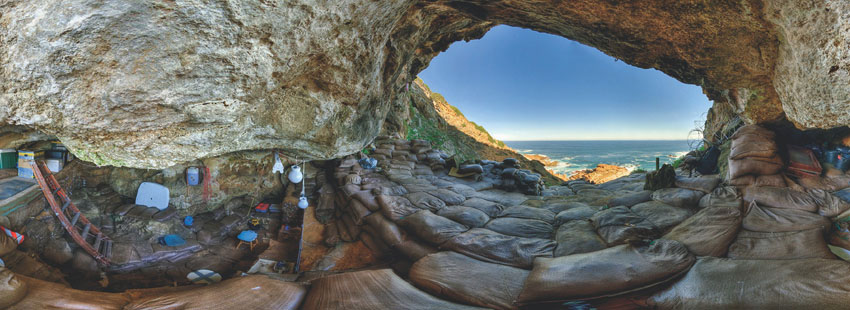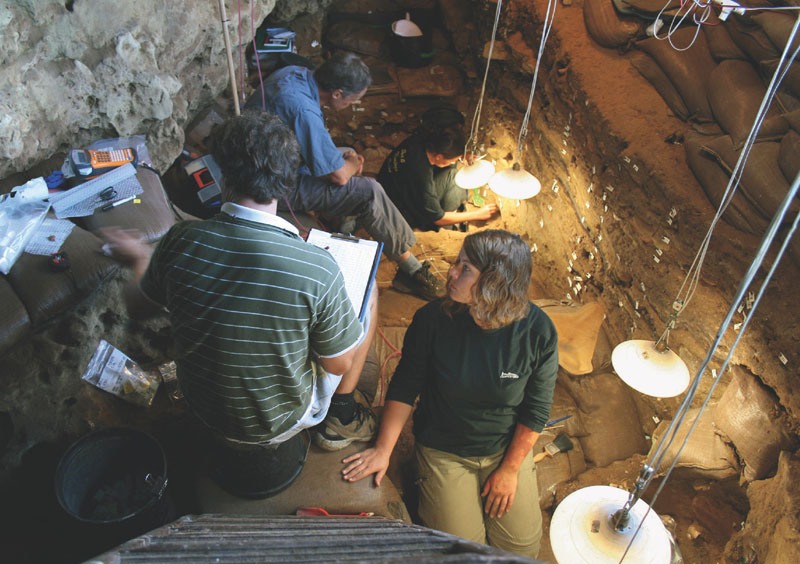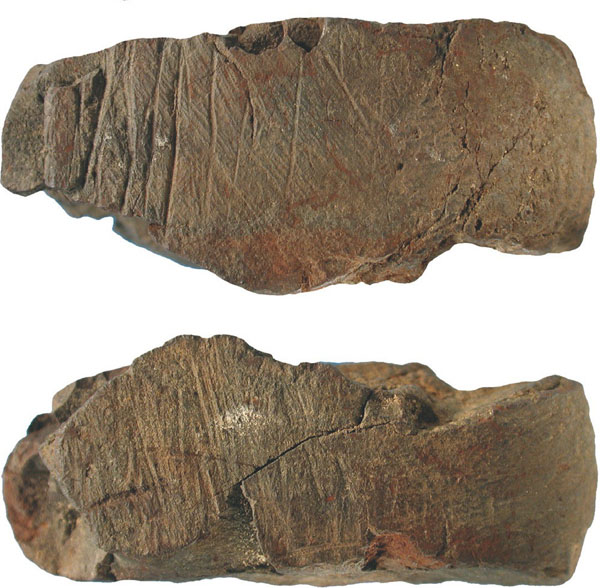
93. Sea-bordering cliff that contains Blombos Cave, visible about half-way up the rise.
Chapter 5: The earliest art of modern humans
Two hundred thousand years ago, during the age when the Neanderthals dominated Europe and central Asia, Homo heidelbergensis had begun to evolve into a new species in Africa. Skeletal remains of archaic members of the species Homo sapiens (to which all peoples of the earth today belong) have been found at two Ethiopian sites: Omo 1, dating to 195,000 years ago, and Herto, 160,000 years ago. By 120,000 years ago these early modern humans had made their way to Tanzania (as evidenced by a skull from Laetoli, known as LH 18, and fossil footprints along the shores of Lake Natron, one set of prints coming from a band of eighteen individuals walking together). By between 115,000 and 90,000 years ago they had travelled as far south as Border Cave and Klasies River Mouth in South Africa, and northwards to Es-Skhul and Qafzeh in Israel.1 Our species was steadily spreading out of its East African homeland, in streams of migration2 following a number of routes. Homo sapiens had begun its long, slow march out of Africa and would in due course come to occupy all the corners of the earth.
Early Homo sapiens art
The dispersal of early modern humans out of Africa is an exciting episode in the story of human creativity, for we can now start to track how the development of new forms of artistic expression developed as people spread across the globe over tens of thousands of years. Did the earliest members of our species leave Africa already equipped with an aesthetic sense, an ability to create and read symbols, and the capacity to hold abstract thought and religious beliefs to explain the mysteries of life, much as we do today? Or did these new kinds of behaviour – that we recognize as distinctively modern in ourselves – emerge slowly, as people spread across the globe? In other words, did people develop fully modern cognition with, or after, the evolution of full biological modernism?
Remarkable recent discoveries in South Africa help us to answer these questions.3 Perched 35 m (115 ft) high in a limestone cliff close to where the Indian Ocean meets the eastern Atlantic seaboard, Blombos Cave offers magnificent views across a distant skyline [93]. What lies inside is well protected under a high sheltering roof that arches 7 m (23 ft) across the cave’s entrance [94, 95]. Beneath the present floor of the cave, deeply buried under alternating layers of yellow, brown and khaki sands interspersed with black, hearthy layers, lay an entire workshop for the processing of paint pigments. Archaeologists have unearthed two paint-mixing palettes made of shell, mineral ochres that had been rubbed to produce powders for the making of paint pastes, and tools used to process those pigments. Even more exceptionally, these individual items were found still neatly arranged together, as if they had been left behind after use only yesterday, though in fact they were abandoned 100,000 years ago.
At Blombos Cave, the highest (and therefore youngest) Middle Stone Age layers are 70,000 years old; lower levels have been dated to 73,000, 77,000, 82,000, 85,000, 94,000 and 97,000 years old. It is deeper still in this layer-cake of sand, at a clearly undisturbed level dating to sometime between 105,000 and 97,000 years ago – the best scientific results indicating somewhere in between, around 101,000 years ago – that the paint-making workshop lay buried.

93. Sea-bordering cliff that contains Blombos Cave, visible about half-way up the rise.
94. Blombos Cave from the outside, excavations in progress.
The discovery of the Blombos Cave workshop rocked the scientific world when it was announced. The palettes were not fragmented into small pieces, as often happens once objects become gradually buried beneath hundreds of kilograms of soil over the course of tens of thousands of years. Nor were the individual items dispersed across the site, as could easily have happened, for example, if an animal had wandered by and, through curiosity or by chance, disturbed the stacked items as they lay exposed on the cave floor. Instead, archaeologist Christopher Henshilwood and his team from the University of Witwatersrand, South Africa, and University of Bergen, Norway, found the workshop virtually intact. The two sets of paint-making toolkits were found neatly stacked just 16 cm (6.3 in.) apart, both in the same layer and therefore of the same great age [96].

95. The interior of Blombos Cave.
A quartzite cobble sat snugly inside the shiny, nacreous bowl-like inner aperture of an abalone shell used for one of the paint palettes, known as TK1 [97]. The cobble has marks on its surface that show it had served to hammer and grind red ochre and porous bone tissue of a kind typically found at the ends of long bones or inside flatter bones, such as the pelvis. When the archaeologists removed the cobble, they found thick red paint still adhered to the shell [98]. Analysis of the paint revealed that it had been made by mixing two kinds of red ochre with a binder derived from the marrow- and fat-rich spongy bone to make a more usable paint paste that would stick when applied to a ‘canvas’. The bone had been burnt before crushing, helping to better release the fatty juices into the paste. Rare fragments of wood charcoal held in the shell suggest that it, too, was probably part of the recipe. Pieces of ochre were also found in the shell container, as were small stone tools that had ochre smeared along various edges and surfaces, including one slab of quartzite stained with pigment indicating that, like the cobble, it had been used to grind ochre. Underneath the shell was the foreleg bone of a carnivore, perhaps a fox, and the shoulder bone of a seal, both stained with ochre along their edges. A bone of a cloven-hoofed animal, possibly an antelope, two other quartzite grinding tools stained with ochre, and another, unstained stone tool were all neatly stored with the abalone shell and its contents.

96. Christopher Henshilwood (at the rear overseeing the excavation) and his team excavating at Blombos Cave. The layer-cake sand layers can be seen on the right-hand side of the excavation pit.

97. Paint-making toolkit TK1 in situ beneath deep, stratified layers of sediment, Blombos Cave, South Africa.

98. The stone cobble separated from the abalone shell as it is being excavated, paint-making toolkit TK1 from Blombos Cave, South Africa. Under the accumulated sediment, the inside of the shell reveals thick red paint.

99. Paint-making toolkit TK2, at Blombos Cave as it is being excavated.
The second toolkit, TK2, was also tightly packed around an abalone shell with red paint in its inner concave surface [99]. That red paint was constituted of exactly the same mix of ochre and bone found in the first palette. The inner surface of the shell, near its outer lip, had been stained red as the paint paste was mixed. A stone tool that had been used to grind crayons of ochre into powder lay against the shell. An ochre crayon lay 5 cm (2 in.) away; small pieces had been flaked off for grinding, and it had also been rubbed to make more powder. The ochre found in the two toolkits does not occur locally: it had to have come from at least a few kilometres away, as did a silcrete stone tool that had been used to flake or grind the ochre. This is important as it implies that people had come to Blombos Cave with a well thought-out plan to make pigment with imported ingredients and tools. The making of paint had come with careful preparation and forethought 100,000 years ago.
We do not know if well-delineated images were created with the paints manufactured at Blombos Cave (or were they just aimed at covering something in red?); nor do we know where such paintings would have been made. The ‘canvas’ could have been a rock surface, a person’s body or an object that people carried around. It appears though that two people may have been working side-by-side, each toolkit more or less identical and containing pigment made using a single formula consisting of multiple ingredients. The fact that both toolkits had been stored so close together, a mere handspan apart, suggests that these two individuals were either kin or close friends, and certainly that they were familiar enough with each other to closely work together and then store their toolkits alongside each other. As we reflect on these ideas, the very fact that we can even begin to realistically imagine not just an evolving species, but such details for individuals so far back in time, is mind-boggling. Some 100,000 years ago, our ancestors took part in creative endeavours that we now take for granted, as for instance when we buy and use paints and crayons. Deep in the recesses of Blombos Cave, the manufacture and use of paint signals something much grander: the beginnings of an active, creative mind, and of what we have come to know as ‘art’.
Artistic activity during the Middle Stone Age of southern Africa
The Blombos Cave paint-making toolkits were used during a period that archaeologists call the Middle Stone Age, which began around 280,000 years ago in East Africa.4 This period began with archaic human behaviour gradually emerging with the onset of biologically modern Homo sapiens around 200,000 years ago. It was during the Middle Stone Age that early modern humans first began to spread across, and then out of, Africa. These humans invented new kinds of stone tools, including long, narrow blades that required greater mastery of knapping techniques; stone and bone points that were hafted onto wooden shafts to make projectiles such as spears and perhaps even arrows; and bone needles to work animal hides [100]. At the rockshelter of Sibudu in South Africa, there is evidence that humans were making bedding out of aromatic and insecticidal plants by 77,000 years ago.5 And, as we have seen at Blombos Cave, for the first time in human evolution there are unmistakable signs of things being decorated by painting with complex paint recipes.
The paint-making toolkits of Blombos Cave, at the very southern tip of Africa, provide the first unambiguous evidence for planned art-making and human thought processes that begin to resemble our own (with more elementary abilities shown by Homo erectus in eastern Asia and Homo heidelbergensis in Africa, as indicated by the Trinil engraved shell, use-worn ochres from Twin Rivers, and perhaps the Berekhat Ram ‘figurine’ from the Golan Heights, for example). There is thus a period of around 100,000 years between the earliest fossil traces of biologically modern humans c. 200,000 years ago and the first clear traces of an ability to prepare and cache multiple ingredients and toolkits for artistic purposes.
100. Bifacial stone points and bone tools from c. 75,000-year-old Middle Stone Age levels at Blombos Cave, relating to a cultural phase known as ‘Still Bay’.

101. Two surfaces of an engraved ochre crayon from Layer 14 of Klasies River Cave 1, dated to between 101,000 and 85,000 years ago.
The idea that the use of ochre represents symbolically mediated behaviour takes a curious twist at Blombos Cave and a site some 350 km (220 miles) to the east of it, Klasies River Cave 1, also on the southern African coast. We would normally associate red ochre with the production of red pigment for painting and the making of imagery. But what about when the ochre crayons are themselves the artworks: when they are themselves decorated with symbols? This is the case at both sites. At Klasies River Cave 1, six ochre crayons were extensively ground between 101,000 and 85,000 years ago, but one is particularly interesting because of the engraved geometric design it carries on its smooth-ground surface [101].6 The engraved lines are pronounced, exhibiting a combination of parallel and angled lines. They had been made with a pointed stone tool, and were not accidentally produced in the act of grinding. The engraved piece is broken, representing a fragment of an originally larger piece, so the full design is not clear.
Similar engravings on ochre were found by Henshilwood and his team at Blombos Cave, where fifteen pieces lay buried in layers above (and therefore more recent than) the two paint-making toolkits already described.7 These were dated between 100,000 and 75,000 years ago and had surfaces smoothed flat and incised with geometric lines. Sometimes the incised lines are rather faint and weathered, making no clear pattern that we could unambiguously identify as image-making. But in two cases, both dated to 75,000 years ago, the pattern and the intent to create a design are unmistakable. One of these, a 5.4-cm-long (2.1 in.) lustrous pink siltstone and fine sandstone, was flaked, ground smooth and then incised with a cross-hatched pattern consisting of two sets of superimposed parallel lines overlaid by a further angled line [102]. The second piece is even more impressive. Measuring 7.6 cm (3 in.) in length, this angular reddish-brown siltstone was first shaped by grinding, after which three sets of parallel lines were incised one over the other to form a cross-hatched pattern on one face [103]. Many of the lines are not clean strokes, but rather were made by repeatedly cutting into the moderately soft rock, exposing a determination to execute a preconceived design. The overall arrangement is clear and clean nonetheless: depending on one’s point of view, we can choose to see it either as a broad pattern of criss-crossing lines, or of abutting diamond shapes framed above, below and across the middle by a latticework of long incised lines.
Whether we see the patterns on the incised ochres from Klasies River Cave 1 and Blombos Cave as the products of imaginative doodling or as designs that were consciously conceived to depict and communicate a particular idea, they signal the creation of a mental template. That template is shaped and controlled. The geometry of the whole was not made accidentally; it was not made by an unthinking and uncultured mind, but rather indicates a way of doing things through symbols and aesthetic balance. The engraved ochres of Blombos Cave are signs of people expressing themselves creatively. This is the stuff of symbolic behaviour and of art. The paint-making toolkits recovered from Blombos Cave announce that art was already being made in South Africa by the Middle Stone Age some 100,000 years ago, and through these incised ochres we see for the first time what some of that imagery looked like by 85,000 to 75,000 years ago.

102. 75,000-year-old engraved ochre piece from Blombos Cave.

103. 75,000-year-old ochre piece from Blombos Cave, showing the engraved latticework pattern.
The use of linear incisions to create aesthetically balanced, geometric designs is repeated at two other sites in South Africa: Diepkloof Rock Shelter, some 17 km (11 miles) inland of the Atlantic coastline, and Klipdrift Shelter, a mere 50 km (30 miles) west of Blombos Cave, this time on ostrich eggshells [104].8 Originally excavated in 1973 by John Parkington and Cedric Poggenpoel from the University of Cape Town, and more recently researched by Pierre-Jean Texier and his team from the Université de Bordeaux 1, some 408 fragments of eggshell, dated to 65,000–55,000 years ago, were recovered from Diepkloof Rock Shelter, each decorated with geometric incisions [105]. A variety of patterns were inscribed onto the eggshells, together giving a sense of the range of cultural expression (much as the sum of Scottish tartan patterns gives a sense of the overarching graphic leitmotif). We can therefore recognize a symbol-making and aesthetic mindset in the manufacturing process, even if we can’t interpret the original meanings of the motifs.

104. Excavations in progress at Diepkloof Rock Shelter, South Africa, where 65,000- to 55,000-year-old geometrically incised ostrich eggshell fragments have been found.

105. Examples of 65,000-to 55,000-year-old incised ostrich eggshell fragments excavated from Diepkloof Rock Shelter.
Klipdrift Shelter is part of a cave complex situated in the De Hoop Nature Reserve, again at the southern tip of South Africa. The shelter has been excavated by Christopher Henshilwood and Karen van Niekerk (the latter from the University of Bergen, Norway) since 2011. Here, in layers dating to between c. 66,000 and 59,000 years ago and associated with an innovative stone artifact assemblage (of a tradition called ‘Howiesons Poort’ that is geographically confined to southern Africa), more than seventy fragments of clearly and deliberately engraved ostrich eggshell were recovered. The designs entail recurring themes, variations of cross-hatching or sub-parallel lines, and most are similar to those reported from layers of a similar age at Diepkloof, and also from Apollo 11 Cave in Namibia.9 The exceptions are several fragments from the upper (most recent) layers that exhibit a finely engraved diamond-shaped cross-hatched pattern, distinctly different to those from layers below, and from the ‘cross-hatched grid motif’ at Diepkloof.
The Diepkloof eggshells are decorated with one of five designs: hatched bands; cross-hatched grids; sub-parallel intersecting lines; reversed curvature; and sub-parallel rectilinear or curved lines. None of the fragments of shell possesses more than a single one of these patterns, indicating that each whole eggshell – or at least each discrete region of eggshell, given that most of the recovered fragments are fairly small – was probably decorated with a single pattern. Some large pieces, up to 8 cm (3 in.) long, allow us to make out the overall design, and support this idea.
There is no doubt that the decorated Diepkloof eggshells (like those from Klipdrift Shelter) are artistic creations produced by a creative mind. As Texier and his team have noted, the repeated patterns signal that rules for composing designs existed, but there was room within the rules for individuals or groups to exercise creative freedom. The ostrich eggs were not simply eaten then discarded, or reused functionally, as receptacles to hold water or the like, but rather, or additionally, were used as a medium by early modern humans to express themselves to the world through symbols that they associated with and that they could carry around in their travels. Those symbols allowed people to portray themselves not just as cultural beings, but as particular kinds of people who belonged to socially organized groups. The symbols that people identified with allowed others to understand something of their identity. The Diepkloof eggshells are signatures of creative minds that enabled people to represent and organize themselves as groups and to interact together through their shared symbols.
Shell beads
Along with its painting paraphernalia, Blombos Cave yielded a number of ancient shell beads from its deeper levels (not quite the oldest in the world, but ancient nonetheless). An assemblage of forty-one perforated Nassarius kraussianus ‘tick’ shells was discovered, like the incised ochres dating to around 75,000 years ago [106]. These marine shells could not have come into the cave by themselves; they were brought there by people, who perforated them with bone points. When examined under a microscope, the edges of the perforated shell walls show that they had been polished round as a result of having been strung [107]. The shells had likely been worn as beads for personal adornment, indicating that people had enhanced how they presented themselves to society through culturally prescribed forms of artificial beautification. This again indicates a modern human mind, reflected in behaviour, that is concerned not just with finding water, food, shelter and a mate, but with how individuals and groups present themselves socially via culture and status in communities of people. As previously mentioned, for rock art specialist Robert Bednarik, beads are important for tracing the origins of modern human behaviour, as simply by being worn they imply a sense of personal style and thus self-awareness.10 Personal adornments, as forms of body art, speak of symbolic expression in a modern fashion.

106. 75,000-year-old perforated Nassarius kraussianus shells from Blombos Cave, South Africa.
107. (top) Six hypothetical ways (using modern shells) that the c. 75,000-year-old Nassarius kraussianus beads from Blombos Cave may have been strung. (above) Experiments with modern Nassarius kraussianus shells show how strung shells would result in polishing along their edges and surfaces.
Beyond Africa
As anatomically modern people left the African continent, we begin to find evidence for symbolic behaviour along the dispersal routes eastwards across southern Asia into Australia, and north and westwards into Europe and northern Asia. At first the evidence is patchy, in part because of the test of time, and especially for those areas where research has been limited. It is in Israel, at the doorstep between northeastern Africa and southwestern Asia, that we find the earliest evidence of early modern humans outside Africa. Here, at the rockshelter site of Es-Skhul on Mount Carmel, two perforated Nassarius gibbosulus shell beads were recovered from layers dating to between 135,000 and 100,000 years ago [108]. The shells were gathered from the shore of the Mediterranean some 3.5 km (2 miles) to the north and carried into the cave. They are associated with early modern human remains and are the oldest known shell beads in the world. In the cave of Qafzeh in the Lower Galilee region, 30 km (20 miles) away, human burials dating to around 92,000 years ago have been found, along with a stone flake incised with short parallel lines,11 ochre used for painting12 and perforated Glycymeris insubrica beads made from shells carried 35 km (22 miles) from the Mediterranean – some painted with red ochre – and used as strung ornaments, probably for personal adornment such as necklaces or on garments [109].

108. Multiple views of two 135,000- to 100,000-year-old perforated Nassarius gibbosulus shell beads from Es-Skhul in Israel.
Little is currently known of developments in artistic capabilities as humans journeyed further eastwards into Asia. What is of great interest, however, is the arrival of people in Australia beyond the far southeastern edge of the Asian continent sometime between 60,000 and 50,000 years ago, for the cultural package that arrived with the earliest Australians would presumably have already developed by the time people crossed from the Southeast Asian seaboard. Hence we find red ochre crayons with facetted edges made when they were rubbed to create pigment as far back as 61,000 ± 13,000 to 45,000 ± 9000 years ago at Madjebebe (aka Malakunanja II), and 53,400 ± 5400 years ago at Nauwalabila 1, both rockshelters in northern Australia’s Arnhem Land region [110].13 At Carpenter’s Gap in the Kimberley region of northwest Australia, archaeologist Sue O’Connor found a slab of limestone rock stained with red ochre, signalling the making of artwork sometime between 50,000 and 37,000 years ago.14 It is uncertain whether the pigment on that rock slab represents a faded image or the result of ochre being ground to make paint for use elsewhere; the traces are too faded to tell for sure. Either way, the processing and use of pigment to make imagery is implied. These Australian findings, dating to around 50,000 years ago and therefore approximately contemporaneous with the earliest Australians, strongly suggest that by the time people arrived in Australia the art of painting was already well established. We will explore exactly what this means for the development of early art in the next two chapters.

109. Glycymeris insubrica shell beads, c. 92,000 years old, from Qafzeh, Israel.

110. Piece of use-worn ochre crayon from Madjebebe (Malakunanja II), northern Australia.